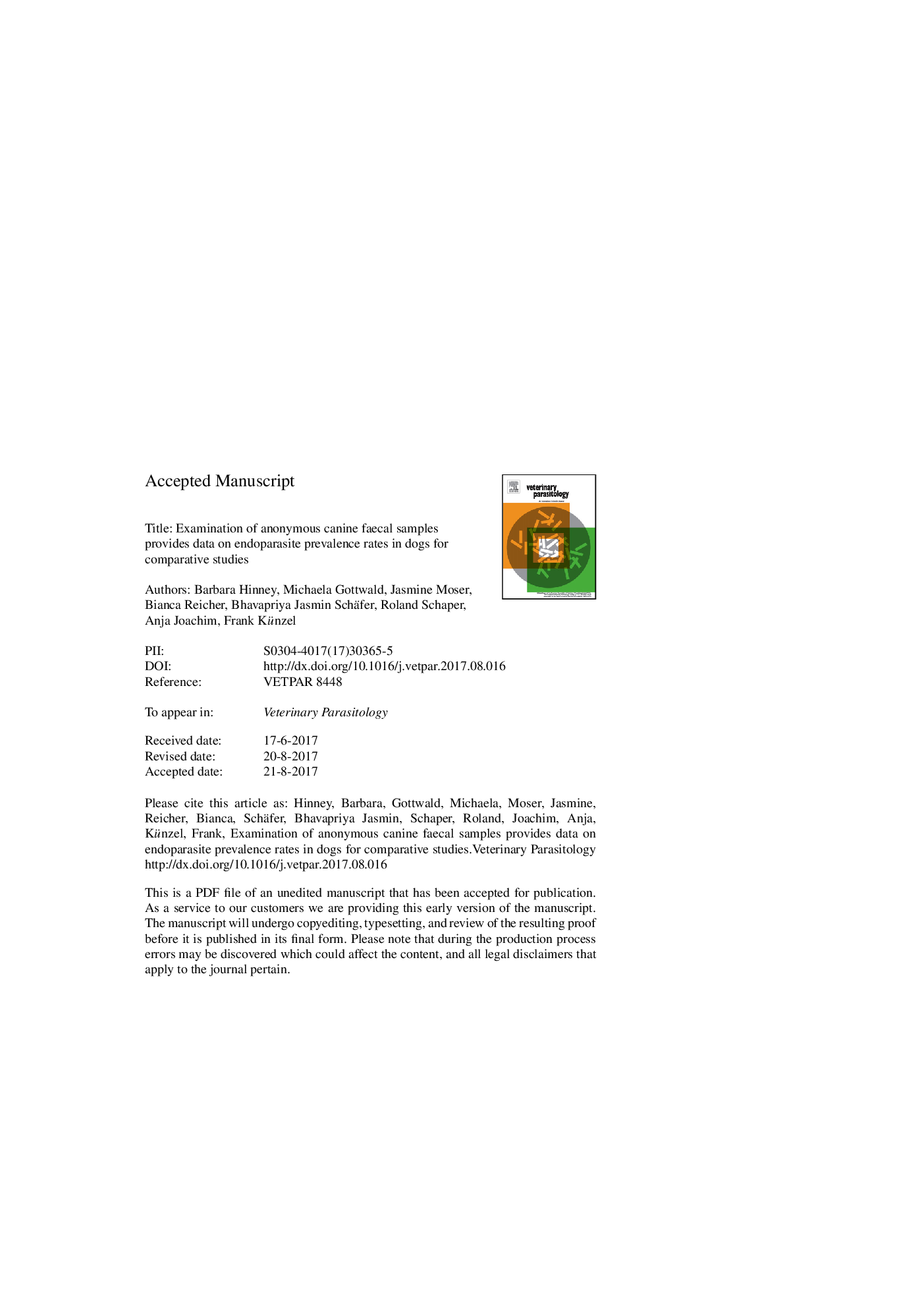| کد مقاله | کد نشریه | سال انتشار | مقاله انگلیسی | نسخه تمام متن |
|---|---|---|---|---|
| 5545684 | 1555631 | 2017 | 39 صفحه PDF | دانلود رایگان |
عنوان انگلیسی مقاله ISI
Examination of anonymous canine faecal samples provides data on endoparasite prevalence rates in dogs for comparative studies
ترجمه فارسی عنوان
بررسی نمونه های مدفوع کانین ناشناس اطلاعات مربوط به میزان شیوع آندو پارازیت در سگ را برای مطالعات مقایسه ای ارائه می دهد
دانلود مقاله + سفارش ترجمه
دانلود مقاله ISI انگلیسی
رایگان برای ایرانیان
کلمات کلیدی
موضوعات مرتبط
علوم زیستی و بیوفناوری
علوم کشاورزی و بیولوژیک
علوم دامی و جانورشناسی
چکیده انگلیسی
Several endoparasites of dogs cannot only be detrimental to their primary host but might also represent a threat to human health because of their zoonotic potential. Due to their high dog population densities, metropolitan areas can be highly endemic for such parasites. We aimed to estimate the prevalence of endoparasites in dogs in the Austrian capital of Vienna by examining a representative number of canine faecal samples and to compare the prevalences with two neighbouring peri-urban and rural regions. In addition we analysed whether the density of dog populations and cleanliness of dog zones correlated with parasite occurrence. We collected 1001 anonymous faecal samples from 55 dog zones from all 23 districts of the federal state of Vienna, as well as 480 faecal samples from the Mödling district and Wolkersdorf with a peri-urban and rural character, respectively. Faeces were examined by flotation and by Baermann technique. Additionally we evaluated 292 Viennese, 102 peri-urban and 50 rural samples for Giardia and Cryptosporidium by GiardiaFASTest® and CryptoFASTest®. Samples from “clean” dog zones were compared to samples from “dirty” zones. The infection rate of Toxocara was surprisingly low, ranging from 0.6% to 1.9%. Trichuris was the most frequent helminth (1.8-7.5%) and Giardia the most frequent protozoan (4.0-10.8%). Ancylostomatidae, Crenosoma, Capillaria, Taeniidae, Cystoisospora and Sarcocystis were found in 1.8-2.2%, 0-0.9%, 0-0.9%, 0-0.6%, 0.3-3.1% and 0-0.6% of the samples, respectively. Samples from “dirty” dog zones in Vienna showed a significantly higher rate of parasites overall (p = 0.003) and of Trichuris (p = 0.048) compared to samples from “clean” dog zones. There were no statistically significant differences in densely vs. less densely populated areas of Vienna. Samples from the rural region of Wolkersdorf had significantly higher overall parasite, Trichuris and Cystoisospora prevalences than the peri-urban Mödling district and Vienna (p = 0.000-0.039), while samples from the Mödling district had a significantly higher Giardia, Crenosoma and Capillaria prevalence than those from Vienna (p = 0.002-0.047). Parasite excretion is dynamic and representative sampling and monitoring are necessary for parasite surveillance. Dog owners should be informed about the zoonotic risk and encouraged to remove dog faeces and dispose of them properly to reduce the infection risk for both other dogs and humans.
ناشر
Database: Elsevier - ScienceDirect (ساینس دایرکت)
Journal: Veterinary Parasitology - Volume 245, 15 October 2017, Pages 106-115
Journal: Veterinary Parasitology - Volume 245, 15 October 2017, Pages 106-115
نویسندگان
Barbara Hinney, Michaela Gottwald, Jasmine Moser, Bianca Reicher, Bhavapriya Jasmin Schäfer, Roland Schaper, Anja Joachim, Frank Künzel,
